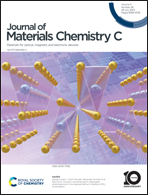Machine learning-assisted screening of effective passivation materials for P–I–N type perovskite solar cells†
Abstract
The introduction of suitable passivation materials has led to a significant improvement in the power conversion efficiency (PCE) of perovskite solar cells (PSCs) in recent years. In this paper, the relationship between the molecular fingerprints of the passivation material and the PCE of p–i–n type PSCs is investigated using machine learning (ML). Data relating to around 100 passivation materials used to passivate the interfaces of perovskite/electron transport layers are collected. It is found that nitrogen atoms and acryloyl groups in the passivation material have the most influence on the PCE of p–i–n type PSCs. Therefore, a non-fullerene material, 3,9-bis(2-methylene-(3-(1,1-dicyanomethylene)-indanone)-5,5,11,11-tetralcis(4-hexylphenyl)-dithieno[2,3-d:2′,3′-d′]-s-indaceno[1,2-b:5,6-b′]-dithiophene (ITIC), which has both nitrogen atoms and acryloyl groups, is selected to passivate perovskite defects. Moreover, according to photoluminescence and time-resolved photoluminescence analyses, treatment with ITIC can enhance charge transport and diminish the defect density of the perovskite layer. Additionally, the Urbach energy of a perovskite film treated with ITIC is reduced from 127.1 meV to 96.8 meV, which reveals that the number of defects on the perovskite surface treated with ITIC is effectively reduced. More importantly, the introduction of ITIC dramatically improves the crystallinity and reduces the surface roughness of the perovskite films. Meanwhile, density-functional theory (DFT) calculations validate that incorporating ITIC into the anti-solvent effectively passivates the uncoordinated Pb2+ ions. In addition, compared with a non-treated PSC, the PCE of the ITIC-treated PSC shows a 20.97% enhancement. To sum up, ML has great application potential in the field of photovoltaics for choosing effective passivation materials in PSCs.

- This article is part of the themed collection: Machine Learning and Artificial Intelligence: A cross-journal collection


 Please wait while we load your content...
Please wait while we load your content...